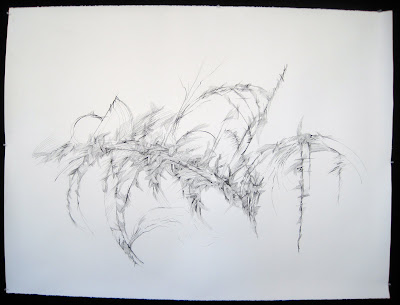Here is a detail of the above drawing:
The marks are a way for me to "write" down what I'm feeling at a much more rapid pace in order to accurately capture my mood in its entirety.
I was experimenting with various frameworks, different compositional layouts so that I can observe how my marks in turn react to the structure. If the structure changes, I noticed that the marks began to behave differently. I love seeing structure and order in the seemingly chaotic world we live in.
Here I introduced a little bit of color and the dotted lines. Color is subtle yet bold on its own. When found within the context of the various marks, it becomes muted, and almost unnoticeable. The dotted lines signify various connections made during the process of journaling, or within one's daily routine.
Here's a detail of the above:
This is the first time I've ever posted my work on the web. I feel a bit vulnerable, but recently I've been asked many times if I have a website of my work yet. It is in the making, so I will use Pineapple Soju as a place to gently introduce my work to those around me.
































